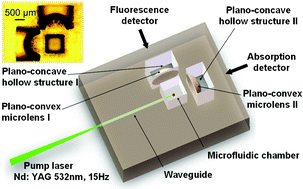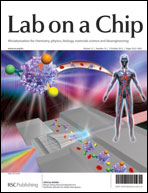Femtosecond laser direct writing is a promising technique for fabricating optofluidic devices since it can modify the interior of glass in a spatially selective manner through multiphoton absorption. The chemical properties of laser-irradiated regions in glass are modified allowing them to be selectively etched by subsequent wet etching using aqueous solutions of etchants such as hydrofluoric (HF) acid. This technique can be used to directly form three-dimensional microfluidic systems. The two-step process can also be used to fabricate free-space optical components such as micromirrors and microlenses inside glass. In addition, femtosecond laser direct writing can alter the optical properties of a substrate to create a wide range of micro-optical components inside glass, including optical waveguides, Mach-Zehnder interferometers, and optical attenuators. The unique ability of femtosecond laser direct writing to simultaneously alter the chemical and optical properties of glass opens up a new avenue for fabricating a variety of optofluidic microchips for biological analysis. Optofluidic microchips fabricated using femtosecond lasers have been used to determine the functions of living microorganisms, determine the concentrations of liquid samples, detect and manipulate single cells, and rapidly screen algae populations. This paper presents a comprehensive review of optofluidic devices for biological analysis fabricated by femtosecond laser processing.

You have access to this article
 Please wait while we load your content...
Something went wrong. Try again?
Please wait while we load your content...
Something went wrong. Try again?


 Please wait while we load your content...
Please wait while we load your content...